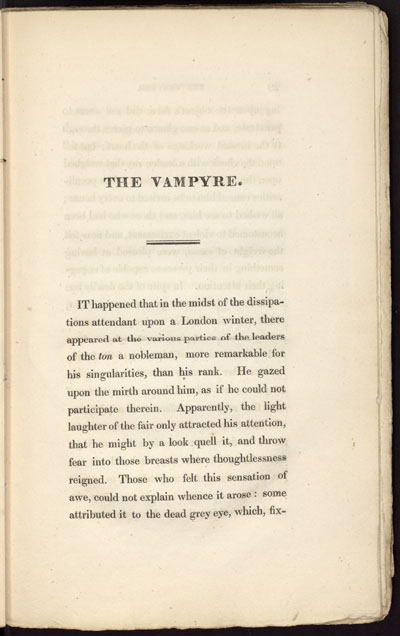

Molly Miller is a graduate student in the School of Information at The University of Texas at Austin. She is studying to become a teen services librarian, but has many other interests, including nineteenth-century British literature, vampires, rare books, and anything to do with the Victorian Era. As part of a research project in Michael Laird’s class “Studies in the Book Arts,” Miller studied a first edition of John William Polidori’s The Vampyre.
Vampires have inspired human imagination for centuries. They even play a huge role in popular culture today, and vampire mythology has been explored in literature, movies, and many other forms of media. While big names such as Bram Stoker’s Dracula come to mind when thinking about the vampire legend, it is easy to overlook the tale that solidified these legends and presented to the world of literature the dark, brooding, mysterious, and somewhat Romantic figure that we recognize as the vampire today. This tale is John William Polidori’s The Vampyre.
Though Polidori’s Lord Ruthven rose to fame and became one of the most important figures for studying the roots of our contemporary idea of the vampire, Polidori himself remained in obscurity for several reasons. Perhaps the most prevalent one is that Polidori did not at first set out to be a writer. He was originally Lord Byron’s personal physician, who traveled with him in Switzerland. On one very cold summer’s night in 1816 (“The Year Without a Summer”), Polidori participated in a challenge to write the scariest ghost story among Byron and his group of friends. This same challenge produced Mary Shelley’s Frankenstein. Three years later, Henry Colburn, publisher and editor of New Monthly Magazine, came across Polidori’s manuscript of The Vampyre and published it serially in his literary magazine under Lord Byron’s name to promote the magazine using Byron’s established celebrity. Although Byron vehemently denied authorship of The Vampyre, it was not enough to disassociate his name from the work, and it became a sensation. When Polidori tried to assert his authorship, Colburn had the tagline “a tale by Lord Byron” removed from the book versions of the story he ordered from London printers Sherwood, Neely, and Jones. Polidori’s name, however, was not added, and the supplementary material printed before and after The Vampyre both relate to Byron in some manner. Therefore, Byron’s name continued to be attached to the work that Polidori had written, and Polidori remained in obscurity.
The Ransom Center holds one of these important London first editions of The Vampyre in the Robert Lee Wolff collection. It is essential to see and read the physical copy of this first edition to get the sense of why Byron’s name continued to be tied to the text even after he publicly denied writing it. It is similarly important to study this original first edition hastily printed for Colburn because of high demand by readers, to understand how the alluring Lord Ruthven would foster our enduring image of the vampire not only as a mythical monster but also as the glamorous seducer in society.
For Further Reading:
“The London Editions of Polidori’s The Vampyre.” by Henry R. Viets, M.D.
Poor Polidori: A Critical Biography of the Author of The Vampyre by D.L. Macdonald